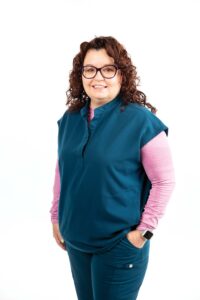Q+A: Interview with Daphne Hardison, MSN, RN, CNML
Published on July 5th, 2023 by Jessica Pasley.
Daphne Hardison, MSN, RN, CNML, is the manager of the Monroe Carell Jr. Children’s Hospital at Vanderbilt ECMO Program, Continuous Renal Replacement Therapy, Vascular Access Team and Wound Ostomy Care.
 Q: What is ECMO and how does it work?
Q: What is ECMO and how does it work?
A: ECMO, or extracorporeal membrane oxygenation, is a life-sustaining mechanical system that temporarily takes over for the heart and lungs of critically ill patients, allowing their organs to rest and recover by removing carbon dioxide from the blood, replacing it with lifesaving oxygen, and returning it to the patient’s circulatory system.
There are two types of this highly specialized treatment — ECMO VA (venoarterial) is used for both the heart and lungs, and ECMO VV (venovenous) is used to support only the lungs when the heart is functioning well.
Q: When did Monroe Carell begin using this technology, and what is the volume of our program?
A: Nationally, the first adult patient was placed on ECMO in 1971, followed by the first pediatric patient in 1975. The technology was first introduced at Monroe Carell in 1989, making it the first ECMO program in Tennessee and propelling it to one of the largest and most successful programs in the world.
Initially used only in the Neonatal Intensive Care Unit at Monroe Carell for neonates in respiratory distress, the program expanded to the congenital heart patient population in 1992, and subsequently, it was used throughout the hospital’s intensive care units for heart and lung support.
During the first 10 years, the program treated about 300 patients. In the nearly two decades since it began, the patient population has tripled. And the numbers continue to rise.
Q: When does a patient need ECMO? And for how long?
A: ECMO can help children suffering from a variety of respiratory distress conditions including congenital diaphragmatic hernia, pulmonary hypertension and meconium aspiration syndrome. It is also used as a bridge to either having a ventricular assist device implanted or used while the patient is awaiting a transplant.
ECMO supports patients for days or weeks while medical teams treat the underlying illness. The longest time a pediatric patient at Monroe Carell has been on ECMO is 96 days.
Q: How many ECMO machines does the hospital have? And how many people does it take to operate?
A: The hospital currently has eight ECMO pumps. There are a host of medical professionals on a patient’s team. Among the most visible will be the nurse and ECMO specialist who stay at the bedside to monitor the patient around the clock.
When the program first began at Monroe Carell, there were 11 members of the team. Today, there are 27.
Q: What has been one of the biggest changes in ECMO over the decades?
A: Patients are much more complex and sicker today than when the technology was first introduced. As medicine has progressed, we are able to place more patients on ECMO who would have never been considered 30 years ago. The technology has come a long way.
The quality of life for patients on ECMO has improved over the years as well. A patient on ECMO can be awake, sit up, get out of bed and eat, which is a large part of the recovery process. If a patient can tolerate movement, that is our goal. It takes an entire team to safely move a patient. We encourage movement as tolerated to help prevent deconditioning.
Q: What is the future of ECMO?
A: At Monroe Carell, we just began our ECMO Transport Team, which allows us to transport pediatric patients on ECMO to our hospital. Advancements have allowed for smaller, transportable pumps that are compatible with an ambulance. The team of six consists of two ECMO specialists, a neonatal transport nurse, respiratory therapist, an advanced EMT and a physician.
Monroe Carell is the largest pediatric transplant center in the area and a regional referral center. We are continually learning and advancing the technology.
